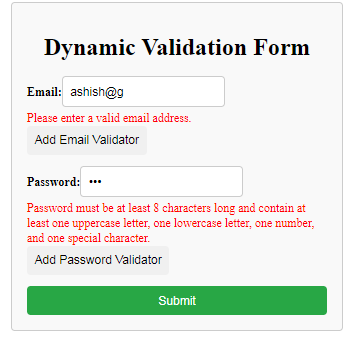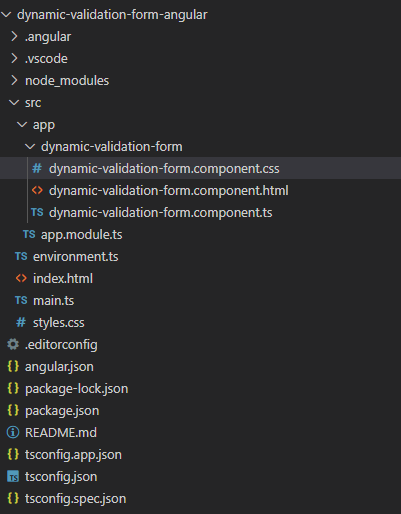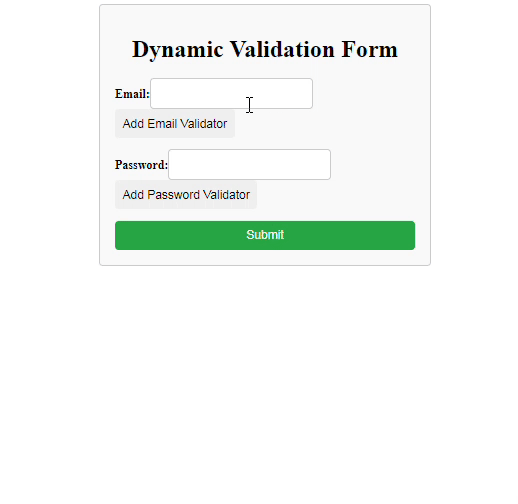How to Add Validator to FormControl After Control is Created in Angular ?
Last Updated :
12 Apr, 2024
Adding a validator to a form typically refers to the process of defining rules or conditions that suggest whether the data entered into the form fields is valid or not. Initially, the form can be submitted without any validation. However, after adding a validation rule, submission is only allowed if the input meets the specified criteria.

Prerequisites:
Steps to create angular project
Step 1: Set Up Angular Project
Install Angular CLI: If you haven’t already, install the Angular CLI globally by running the following command:
npm install -g @angular/cli
Step 2: Create Angular Project: Create a new Angular project using Angular CLI:
ng new dynamic-validation-form-angular
Navigate to Project Directory: Enter the project directory:
cd dynamic-validation-form-angular
Generate Component: Generate a new component for the dynamic validation form:
ng generate component dynamic-validation-form
Project Structure:

Dependencies:
"dependencies": {
"@angular/animations": "^17.3.0",
"@angular/common": "^17.3.0",
"@angular/compiler": "^17.3.0",
"@angular/core": "^17.3.0",
"@angular/forms": "^17.3.0",
"@angular/platform-browser": "^17.3.0",
"@angular/platform-browser-dynamic": "^17.3.0",
"@angular/router": "^17.3.0",
"rxjs": "~7.8.0",
"tslib": "^2.3.0",
"zone.js": "~0.14.3"
}Changing file structure:
- Remove unnecessary files, keep the project clean with required files as shown in project structure
- Create dynamic-validation-form folder inside app with 3 files as shown above with the following code.
- create app.module.ts inside app folder with following code
- create environment.ts and main.ts file inside src with following code and replace content of src/index.html
HTML
<!-- dynamic-validation-form.component.html -->
<div class="form-container">
<h1 class="form-title">Dynamic Validation Form</h1>
<form (submit)="handleSubmit($event)" class="form">
<div class="form-group">
<label class="form-label">Email:</label>
<input
type="email"
[(ngModel)]="emailValue"
(change)="handleEmailChange($event)"
class="form-control"
[required]="isEmailRequired"
/>
<div *ngIf="isEmailRequired" class="error">{{ emailError }}</div>
<button
type="button"
(click)="handleAddEmailValidator()"
class="btn add-validator-btn"
>
Add Email Validator
</button>
</div>
<div class="form-group">
<label class="form-label">Password:</label>
<input
type="password"
[(ngModel)]="passwordValue"
(change)="handlePasswordChange($event)"
class="form-control"
[required]="isPasswordRequired"
/>
<div *ngIf="isPasswordRequired" class="error">{{ passwordError }}</div>
<button
type="button"
(click)="handleAddPasswordValidator()"
class="btn add-validator-btn"
>
Add Password Validator
</button>
</div>
<button type="submit" class="btn submit-btn">Submit</button>
</form>
</div>
<!-- src/index.html -->
<!DOCTYPE html>
<html lang="en">
<head>
<meta charset="UTF-8">
<title>Dynamic Validation Form Angular</title>
<base href="/">
<meta name="viewport" content="width=device-width, initial-scale=1">
</head>
<body>
<app-dynamic-validation-form></app-dynamic-validation-form>
</body>
</html>
/*dynamic-validation-form.component.css*/
.form-container {
width: 100%;
max-width: 400px;
margin: 0 auto;
padding: 20px;
border: 1px solid #ccc;
border-radius: 5px;
background-color: #f9f9f9;
}
.form-title {
text-align: center;
margin-bottom: 20px;
}
.form {
display: flex;
flex-direction: column;
}
.form-group {
margin-bottom: 15px;
}
.form-label {
font-weight: bold;
}
.form-control {
padding: 10px;
border: 1px solid #ccc;
border-radius: 5px;
font-size: 16px;
}
.error {
color: red;
margin-top: 5px;
}
.btn {
padding: 10px;
border: none;
border-radius: 5px;
font-size: 16px;
cursor: pointer;
transition: background-color 0.3s ease;
}
.btn:hover {
background-color: #007bff;
color: #fff;
}
.add-validator-btn {
margin-right: 10px;
}
.submit-btn {
background-color: #28a745;
color: #fff;
}
.submit-btn:hover {
background-color: #218838;
}
//dynamic-validation-form.component.ts
import { Component } from '@angular/core';
@Component({
selector: 'app-dynamic-validation-form',
templateUrl: './dynamic-validation-form.component.html',
styleUrls: ['./dynamic-validation-form.component.css'],
})
export class DynamicValidationFormComponent {
emailValue: string = '';
passwordValue: string = '';
isEmailRequired: boolean = false;
isPasswordRequired: boolean = false;
emailError: string = '';
passwordError: string = '';
handleEmailChange(event: any): void {
this.emailValue = event.target.value;
}
handlePasswordChange(event: any): void {
this.passwordValue = event.target.value;
}
handleAddEmailValidator(): void {
this.isEmailRequired = true;
}
handleAddPasswordValidator(): void {
this.isPasswordRequired = true;
}
handleSubmit(event: any): void {
event.preventDefault();
if (this.isEmailRequired &&
!this.isValidEmail(this.emailValue)) {
this.emailError = 'Please enter a valid email address.';
return;
}
if (this.isPasswordRequired &&
!this.isValidPassword(this.passwordValue)) {
this.passwordError =
'Password must be at least 8 characters
long and contain at least one uppercase
letter, one lowercase letter, one number,
and one special character.';
return;
}
this.emailError = '';
this.passwordError = '';
alert('Form submitted successfully!');
}
isValidEmail(email: string): boolean {
const emailRegex = /^[^\s@]+@[^\s@]+\.[^\s@]+$/;
return emailRegex.test(email);
}
isValidPassword(password: string): boolean {
const passwordRegex =
/^(?=.*[a-z])(?=.*[A-Z])(?=.*\d)
(?=.*[@$!%*?&])[A-Za-z\d@$!%*?&]{8,}$/;
return passwordRegex.test(password);
}
}
//src/environment.ts
export const environment = {
production: false,
apiUrl: 'http://localhost:3000/api'
// Add other environment variables as needed
};
//src/app/app.module.ts
import { NgModule } from '@angular/core';
import { BrowserModule } from '@angular/platform-browser';
import { FormsModule } from '@angular/forms';
import { DynamicValidationFormComponent }
from './dynamic-validation-form/dynamic-validation-form.component';
@NgModule({
declarations: [
DynamicValidationFormComponent
],
imports: [
BrowserModule,
FormsModule
],
providers: [],
bootstrap: [DynamicValidationFormComponent]
})
export class AppModule { }
// src/main.ts
import { enableProdMode } from '@angular/core';
import { platformBrowser } from '@angular/platform-browser';
import { AppModule } from './app/app.module';
import { environment } from './environment';
if (environment.production) {
enableProdMode();
}
platformBrowser().bootstrapModule(AppModule)
.then(module => { })
.catch(err => console.error(err));
Run the Angular Application using the following command.
ng serve
Output:

Share your thoughts in the comments
Please Login to comment...